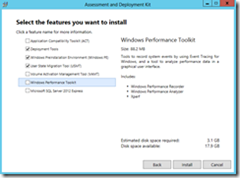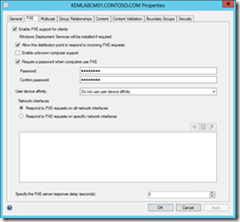Migration and Deployment: 5 Steps to Deploying Windows 8 with System Center 2012 Service Pack 1 (Part 3 of 19)
In Part 2 of the Migration and Deployment blog series, Kevin Remde explained how free tools such as the Windows Assessment and Deployment Kit (ADK) and Microsoft Deployment Toolkit (MDT) could be used to deploy Windows 8 in a “Light Touch” or semi-automated fashion. In Part 3, Keith Mayer explains the use of a for fee tool – System Center 2012 SP1 (Configuration Manager) that can be used to fully automate the deployment of Windows 8. Keith provides a simple 5 step process to configure your Windows 8 image for deployment.
I am including a short snippet from Keith Mayer’s post below.
Service Pack 1 for System Center 2012 Configuration Manager ( “ConfigMgr 2012 SP1” ) adds the ability to deploy Windows 8 operating system images. As you’ll see in this article, this OS deployment process is very similar to what many IT Pros have used in the past for deploying Windows 7 and prior operating systems with ConfigMgr 2012 RTM. However, there’s several new features to help make OS deployment easier and a couple considerations if you’re planning an upgrade of an existing RTM installation.
In this article, I’ll outline the major tasks involved with Windows 8 OS deployment in ConfigMgr 2012 SP1 and also present the new features and considerations along the way that will make our lives easier when deploying operating systems.
- Want to follow along? Download System Center 2012 with SP1 so that you have the bits you’ll need to follow along in this article.
NOTE: This article is Part 3 of a new 19-Part series on Migration and Deployment topics. Be sure to check out Kevin Remde’s Full of IT blog for the full index to all articles in the series.
OS Deployment Steps
Like the System Center 2012 RTM bits, ConfigMgr 2012 SP1 involves the same general steps ( but with some welcome new features ) when deploying operating systems. These steps include:
- Install Prerequisites for OS Deployment
- Prepare Boot Images
- Add Operating System Image
- Define a Task Sequence
- Deploy a Task Sequence
Note that when deploying a customized operating system image, an additional step is required to build and capture the customized image prior to defining a task sequence in Step 4. In this article, we’ll be stepping through the deployment of a standard Windows 8 operating system image. In a future article in this series, we’ll cover the steps needed to build and capture a customized Windows 8 image.
Step 1 - Install Prerequisites for OS Deployment
Prior to using the OS Deployment features of ConfigMgr 2012 SP1, the below prerequisites should be installed.
- Windows Assessment and Deployment Kit ( ADK ) for Windows 8
The new Windows ADK replaces the former requirement in the RTM bits for the WAIK toolkit. When installing the ADK on a ConfigMgr 2012 SP1 site system, the following specific components must be installed:
- Windows PE 4 – the Windows Preinstallation Environment minimal boot code
- USMT 5.0 – a scriptable tool for migrating user state information
- Windows Deployment Tools – tools for customizing Windows images, such as DISM, Windows SIM and OSCDIMG. Note that the ImageX tool has been deprecated in Windows 8 and has been replaced with DISM.

Installing the Windows ADK for Windows 8
- Windows Deployment Services ( WDS ) and DHCP
WDS and DHCP are still required if you plan to use OS deployments initiated via PXE boot. The only major change introduced by SP1 in this area is that all System Center 2012 site system roles, including distribution points, can now be run on Windows Server 2012. Like Windows Server 2008 and 2008 R2, Windows Server 2012 includes WDS as a native Windows Server Role that System Center will install when enabling a distribution point for PXE support.

Enabling a Distribution Point for PXE Boot
If you’re planning to use PXE-initiated deployments, see Planning for PXE-Initiated Operating System Deployments for the configuration details.
- Internet Information Services ( IIS )
Like the RTM bits, ConfigMgr 2012 SP1 still relies on IIS for the distribution point, state migration point and management point roles that are leveraged in an OS deployment process. For specific requirements for each role, see Prerequisites for Site System Roles for details.
Please read Keith’s full blog post here:
Harold Wong